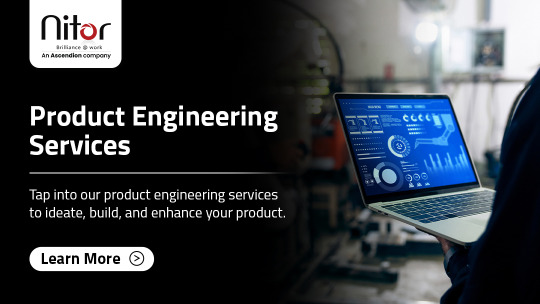#Software Product Engineering Services company
Text
Product engineering services are something that gives a clear view of the businesses. In today’s realm of software product engineering services company, clarifying their important role in today’s fast-paced IT landscape. From ideation to launch, it outlines the stages, benefits, and crucial factors in choosing the right service provider. Moreover, product engineering service provider firms help in building your business with the latest technologies and tools
#product engineering consulting#product engineering consulting services#software product engineering services company#iROM Technologies
0 notes
Photo

Software Product Engineering Company - Tntra
Tntra is a leading software product engineering company focusing on innovation, IP-led product development, IT services, process reengineering, and digital transformation.
Read more: https://www.tntra.io/
#software product engineering#software product engineering companies#Software product Engineering company#software product engineering services#software product engineering services company#software product engineering solutions
0 notes
Text
Best Software Development Services in India

Introduction:
Empowering Businesses with the Best Software Development Services in India: Microlent Systems - In the dynamic digital era, businesses across the globe seek to harness the power of software development to propel their growth and success. India, known for its tech-savvy talent and innovation-driven ecosystem, has become a hub for top-notch software development services. Among the frontrunners in this domain, Microlent Systems stands tall as one of the leading software development companies in India. In this blog post, we will explore how Microlent Systems empowers businesses with its exceptional software solutions, driving innovation, and meeting diverse industry needs.
Expertise and Experience:
At the heart of Microlent Systems lies a team of seasoned professionals with extensive expertise in software development. With a deep understanding of various technologies, programming languages, and frameworks, they possess the skills to craft bespoke software solutions for businesses of all sizes and industries. Their wealth of experience ensures that each project is executed seamlessly, meeting deadlines and exceeding expectations.
Comprehensive Software Solutions:
Microlent Systems offers comprehensive software development services that cover the entire spectrum of IT requirements. From web and mobile applications to enterprise solutions, e-commerce platforms, and custom software, the company delivers end-to-end solutions that cater to the unique needs of clients. Their client-focused approach ensures that every software product is aligned with the business goals and objectives of the customer.
Cutting-Edge Technologies:
Staying ahead in the rapidly evolving tech landscape is imperative, and Microlent Systems takes this to heart. The company adopts cutting-edge technologies, best practices, and modern development methodologies to create robust and future-proof software solutions. By leveraging emerging technologies such as Artificial Intelligence, Machine Learning, and IoT, Microlent Systems enables businesses to gain a competitive edge in their respective markets.
Agile Development Methodology:
Agility is at the core of Microlent Systems' software development process. By adhering to agile methodologies, the company ensures that projects are executed in iterative and collaborative cycles. This approach facilitates better communication, flexibility to adapt to changing requirements, and quick delivery of high-quality software solutions.
Client-Centric Approach:
Microlent Systems places the utmost importance on understanding the unique needs of its clients. Their client-centric approach involves active collaboration, thorough requirement analysis, and regular updates throughout the development process. This ensures that the software aligns perfectly with the client's vision and delivers tangible value to their business.
Robust Quality Assurance:
Quality is a non-negotiable aspect of Microlent Systems' software development services. The company employs stringent quality assurance measures, including thorough testing and debugging, to ensure that the software is bug-free, secure, and performs optimally. The dedication to quality results in software solutions that stand the test of time and deliver exceptional user experiences.
Conclusion:
In the bustling landscape of software development services in India, Microlent Systems shines as a beacon of excellence. With its unmatched expertise, comprehensive solutions, cutting-edge technologies, agile methodologies, client-centricity, and robust quality assurance, Microlent Systems stands tall as one of the leading software development companies in India.
For businesses seeking innovative and tailor-made software solutions to drive growth and success, partnering with Microlent Systems is a transformative step towards digital empowerment. Embrace the power of Microlent Systems' software development services to unlock your business's true potential and stay ahead in the ever-competitive digital realm.
#software development#web development#dubai#softwaredevelopment#software development services#affordable software development services#software development company#custom software development#custom software product engineering services company
2 notes
·
View notes
Link
Employing dedicated software teams has many advantages, including reasonable costs, professional dedication, high skill levels, and more. According to the report, outsourcing is frequently done to cut costs. Many organisations are under stress due to a lack of talent or other problems. As a result, businesses have discovered that outsourcing is the best way to address this problem. The best way to maximize benefits is to hire a team of software app developers, which can be done in order to make educated selections.
Discover the types of software development, benefits, and things to consider before hiring a dedicated software and app development company.
#web development#hire software development team#software development partner#hiring a software development team#dedicated software development team#software development processes#Agile development#benefits of hiring a software development team#DevOps#fintech software development company#hire software developers#Mobile App Development#Rapid application development#software and app development company#Software Consulting Services#Software Development#software development company#software development for healthcare app#Software development team#software product engineering#types of software development models#Waterfall development
2 notes
·
View notes
Text
Shanti Technology ranks among the top ERP software providers in Madhya Pradesh. STERP Software Pvt. Ltd. (Previously Known as Shanti Technology), is a Leader in Engineering and manufacturing ERP software in India, with headquarters in Vadodara, Gujarat. STERP Software Pvt. Ltd. has branch offices located in various cities across India such as Ahmedabad, Rajkot, and Surat in Gujarat, Mumbai and Pune in Maharashtra, as well as Indore in Madhya Pradesh.
If you are looking for an excellent as well as noted ERP Software Company in Madhya Pradesh, Shanti Technology is the right place for you.
#ERP software providers in Madhya Pradesh#ERP Software Company in Madhya Pradesh#ERP software Companies in Madhya Pradesh#ERP software for engineering companies#ERP software#sales and CRM#payroll#quality control#desigg and production#purchase and inventory control#finance#service
6 notes
·
View notes
Text

Embark on a global bug hunt with our SDET team, leveraging cloud-based mobile testing to ensure your app achieves flawless performance across all devices and networks. With cutting-edge tools and a meticulous approach, we identify and eliminate bugs before they impact your users. https://rb.gy/jfueow #SDET #BugHunt #CloudTesting #MobileAppQuality #FlawlessPerformance SDET Tech Pvt. Ltd.
#Software Testing Companies in India#Software Testing Services in India#Test Automation Development Services#Test Automation Services#Performance testing services#Load testing services#Performance and Load Testing Services#Software Performance Testing Services#Functional Testing Services#Globalization Testing services#Globalization Testing Company#Accessibility testing services
Agile Testing Services#Mobile Testing Services#Mobile Apps Testing Services#ecommerce performance testing#ecommerce load testing#load and performance testing services#performance testing solutions#product performance testing#application performance testing services#software testing startups#benefits of load testing#agile performance testing methodology#agile testing solutions#mobile testing challenges#cloud based mobile testing#automated mobile testing#performance engineering & testing services#performance testing company#performance testing company in usa
0 notes
Text

The pressing question now is whether to host the mobile testing process internally or to leverage one of the many cloud-based mobile testing tools available today. Click Here:https://shorturl.at/VGKgh
#Software Testing Companies in India#Software Testing Services in India#Test Automation Development Services#Test Automation Services#Performance testing services#Load testing services#Performance and Load Testing Services#Software Performance Testing Services#Functional Testing Services#Globalization Testing services#Globalization Testing Company#Accessibility testing services
Agile Testing Services#Mobile Testing Services#Mobile Apps Testing Services#ecommerce performance testing#ecommerce load testing#load and performance testing services#performance testing solutions#product performance testing#application performance testing services#software testing startups#benefits of load testing#agile performance testing methodology#agile testing solutions#mobile testing challenges#cloud based mobile testing#automated mobile testing#performance engineering & testing services#performance testing company#performance testing company in usa
1 note
·
View note
Text
EMBEDDED SYSTEM FOR INDUSTRIAL AUTOMATION
Introduction
Embedded systems have transformed industrial automation, leading to major increases in efficiency, safety, and productivity. These specialized computing systems, which are integrated into larger mechanical or electrical systems, perform specific functions under real-time computing restrictions. They are widely used in a variety of industries, including manufacturing, energy, transportation, and healthcare. This article examines the importance of embedded systems in industrial automation, including their benefits, uses, and future prospects.
The Use of Embedded Systems in Industrial Automation
Embedded systems are at the heart of industrial automation, allowing complicated processes to run smoothly. They combine hardware and software to complete specific, predefined tasks, frequently under strict real-time constraints. The main functions of embedded systems in industrial automation are:
1.Process Control: Embedded systems monitor and control industrial processes, assuring peak performance and safety compliance. They regulate factors such as temperature, pressure, and flow rates in real time, allowing for precise control over manufacturing operations.
2.Data Acquisition: These systems capture data from a variety of sensors and equipment, allowing for continuous monitoring of industrial processes. This information is crucial for performance analysis, predictive maintenance, and quality assurance.
3.Communication: Embedded systems facilitate communication between different components of an industrial network. They support various communication protocols, ensuring interoperability and seamless data exchange across the network.
4.Human-Machine Interface (HMI): Embedded systems provide interfaces for operators to interact with industrial equipment. HMIs, such as touchscreens and control panels, allow operators to monitor system status, input commands, and receive feedback.
Benefits of Embedded Systems for Industrial Automation
The integration of embedded systems in industrial automation provides various benefits:
1.Increased Efficiency: Automated systems can run continually without tiring, lowering downtime and boosting total productivity. Embedded systems optimize processes by making real-time adjustments based on sensor data, resulting in better resource use.
2.Enhanced Safety: Embedded systems increase safety by monitoring vital parameters and alerting or shutting down when irregularities are discovered. They also allow for the use of advanced safety standards, such as emergency stop functions and fail-safe mechanisms.
3.Cost Savings: Automation lowers labor expenses and reduces human error, leading to cost savings. Furthermore, predictive maintenance facilitated by embedded technologies can help to avoid costly equipment breakdowns and increase machinery lifespan.
4.Scalability: Embedded systems can be scaled to meet the needs of a wide range of industrial applications, including small-scale operations and big, complex manufacturing plants. They can be quickly upgraded or reprogrammed to meet changing manufacturing requirements.
Application of Embedded Systems in Industrial Automation
Embedded systems are used in a variety of industrial automation applications.
1.Manufacturing uses embedded systems to manage robotic arms, conveyor belts, and CNC machines, assuring precision and uniformity in production. They also manage inventories and logistics.
2.Energy: In the energy industry, embedded systems monitor and control electricity generation, delivery, and consumption. They are critical in managing renewable energy sources like wind and solar by optimizing their integration into the system.
3.Transportation: Embedded systems are used to manage traffic, control vehicles, and monitor infrastructure. They improve the efficiency and safety of transportation networks, including railways and smart highways.
4.Healthcare: Embedded systems regulate medical instruments and equipment, ensuring precise and dependable performance. They are utilized in diagnostic devices, patient monitoring systems, and automated laboratory instruments.
Future Prospects
The future of embedded systems in industrial automation looks bright, thanks to technological breakthroughs such as the Internet of Things (IoT), artificial intelligence (AI), and machine learning. These advancements will allow for more comprehensive data analysis, predictive maintenance, and automated decision-making.
1.IoT Integration: The combination of IoT and embedded systems will result in networked industrial settings in which devices interact and collaborate effortlessly. This will result in better, more responsive automation systems.
2.AI and machine learning algorithms can be integrated into industrial systems to analyze large volumes of data and optimize processes. These technologies will help with predictive maintenance, process optimization, and defect identification.
3.Edge computing moves computational power closer to the source of data, lowering latency and boosting real-time decision-making. Embedded systems with edge computing capabilities will allow for faster and more efficient automation operations.
4.Cybersecurity will become increasingly important as industrial automation systems become more networked. Future embedded systems will include improved security capabilities to defend against cyber threats and maintain the integrity of industrial operations.
Conclusion
Embedded systems are at the heart of industrial automation, boosting efficiency, safety, and innovation across a variety of industries. As technology advances, the capabilities of these systems will increase, resulting in increasingly more complex and intelligent automation solutions. The integration of IoT, AI, and edge computing will further change industrial operations, ushering in a new era of smart manufacturing and more.
https://avench.com/

#embedded software development company#embedded product design#value engineering#hardware design#iot development services
1 note
·
View note
Text
Unlocking Innovation: Inside the World of Software Product Development Companies

In today's digitally-driven world, software is the backbone of innovation across industries. From mobile apps that streamline daily tasks to complex enterprise solutions that revolutionize businesses, the demand for high-quality software products is ever-growing. Behind these cutting-edge solutions are software product development companies, the unsung heroes of technological advancement.
What is a Software Product Development Company?
A software product development company specializes in designing, developing, and maintaining software products for a wide range of clients. Unlike bespoke software development, where projects are tailored to meet specific client needs, product development companies focus on creating scalable, market-ready solutions that can be deployed to a broader audience.
The Role of Software Product Development Companies:
At the heart of every successful software product development company lies a commitment to innovation and excellence. These companies serve as incubators of creativity, bringing together multidisciplinary teams of engineers, designers, and product managers to conceptualize, build, and launch software products that address real-world challenges.
The Software Development Lifecycle:
The journey from concept to launch is governed by the software development lifecycle (SDLC), a structured process that guides the development of software products from inception to retirement. The SDLC typically encompasses several phases, including requirements gathering, design, development, testing, deployment, and maintenance.
Key Components of a Software Product Development Company:
1. Cross-functional Teams: Software product development companies rely on cross-functional teams that collaborate closely to deliver exceptional results. These teams often include software engineers, UX/UI designers, quality assurance specialists, and product managers, each bringing their unique expertise to the table.
2. Agile Methodologies: Agile methodologies, such as Scrum and Kanban, are commonly employed in software product development companies to enable iterative, adaptive, and collaborative development. By breaking down projects into small, manageable increments, teams can respond quickly to changing requirements and deliver value incrementally.
3. User-Centric Design: User experience (UX) design plays a pivotal role in the success of software products. Software product development companies prioritize user-centric design principles, ensuring that products are intuitive, accessible, and delightful to use.
4. Quality Assurance: Quality assurance (QA) is paramount in software development, ensuring that products meet the highest standards of reliability, security, and performance. Through automated testing, manual testing, and continuous integration/continuous deployment (CI/CD) pipelines, software product development companies strive to deliver bug-free, resilient software products.
Challenges and Opportunities:
While software product development offers immense opportunities for innovation and growth, it is not without its challenges. Rapid technological advancements, evolving customer expectations, and intense market competition necessitate agility, adaptability, and a relentless focus on continuous improvement. Moreover, navigating the complexities of intellectual property rights, data privacy regulations, and cybersecurity threats requires vigilance and expertise.
Software product development companies are the driving force behind some of the most transformative innovations of our time. Through their dedication to excellence, collaboration, and innovation, these companies are shaping the future of technology and empowering businesses and individuals to thrive in an increasingly digital world. As the demand for software products continues to soar, the role of software product development companies will only grow in significance, unlocking new possibilities and pushing the boundaries of what is possible.
#software development#software product development#software product engineering#services#tudip#tudip technologies#Software product development companies
1 note
·
View note
Text
The Agile Edge: Million-Dollars Product Engineering Methodologies

Agile methodologies have revolutionized product engineering, departing from traditional approaches and influencing various industries. This article explores how Agile principles have reshaped product development, emphasizing dynamic, customer-focused processes within Agile Product Engineering. It will highlight the benefits and challenges of integrating Agile into product engineering.
Understanding Agile Methodologies
Agile emerged in 2001 with the publication of the Agile Manifesto, a response to the limitations of traditional software development models like Waterfall. Founded on four principles, Agile emphasizes human interaction, delivering functional software, ongoing customer collaboration, and flexibility to adapt to change. These principles drive iterative and incremental development processes, fostering collaboration and responsiveness in product engineering.
The Evolution of Product Engineering
Product engineering traditionally followed sequential models like Waterfall, rooted in industries where changes are costly and time-consuming. However, the fast-paced technological landscape and evolving market demands necessitated a shift towards Agile methodologies.
Agile's iterative approach enables teams to adapt to changing requirements and market conditions swiftly. This transition to Agile has fostered environments prioritizing collaboration, speed, and customer satisfaction, revolutionizing product engineering to be more responsive and innovative.
Benefits of Agile in Product Engineering
Agile methodologies reduce time to market by embracing iterative development and quick adaptation to market changes, ensuring products are relevant and timely.
Enhanced collaboration and transparency in Agile teams foster better information flow and cohesive dynamics, breaking down silos.
Continuous testing and feedback loops in Agile ensure improved product quality through early issue detection and resolution.
Agile's customer-centric approach involves regular customer interaction and feedback integration, enhancing satisfaction and reducing the risk of developing irrelevant products.
Cross-functional collaboration and Risk Management
Agile emerged on the foundation of self-organizing, cross-functional teams. These teams bring together diverse skills and perspectives, fostering a more holistic approach to problem-solving. This team structure empowers members to take ownership of their work and encourages innovative solutions, enhancing team morale and productivity.
Agile's iterative nature allows teams to assess and manage risks continuously. Regular reviews and retrospectives help identify potential issues early, allowing for timely interventions. Agile also encourages experimentation and learning from failures, essential for innovation and continuous improvement in product engineering.
Challenges in Implementing Agile Methodologies
Implementing Agile methodologies requires a significant cultural shift, embracing collaboration, continuous learning, and adaptability. Resistance to change can hinder adoption due to Agile's need for openness and transparency. Scaling Agile to larger teams adds complexity, requiring effective communication and coordination for consistency.
Maintaining a balance between flexibility and project management controls is crucial to prevent projects from becoming unstructured or deviating from objectives. Finding the right balance between agility and aligning with business goals remains a critical challenge in Agile implementation.
Agile vs. Traditional Methodologies: A Comparative Analysis
Comparing Agile and Waterfall Methodologies
Agile is a form of iterative development where requirements and solutions evolve through collaboration. It offers flexibility, promotes customer involvement, and allows for rapid change adaptation.
Waterfall
The Waterfall methodology follows a sequential design process, typically used in software development, where progress flows downwards through distinct phases. It is known for its structured approach, with each stage requiring full completion before the next begins.
Advantages and Limitations
Advantages of Agile
1. Greater adaptability to changing requirements.
2. Enhanced customer satisfaction due to continuous involvement.
3. Early and predictable delivery.
4. Improved product quality through frequent testing.
Advantages of Waterfall
1. Clear structure and milestones.
2. Easier to manage due to its linear nature.
3. Well-suited for projects with well-defined requirements and limited scope changes.
Limitations of Agile:
1. It can be challenging to scale in large organizations.
2. Requires a significant shift in organizational culture.
3. Risk of scope creep without proper project control.
Limitations of Waterfall:
1. Less flexibility to adapt to changes.
2. Due to the lengthy development cycle, there is a higher risk of delivering a product that fails to meet current market needs.
3. Needs to be more efficient in addressing issues that arise late in the development process.
Future Trends and Agile's Evolving Role
As emerging technologies like AI, IoT, and blockchain shape the future, Agile methodologies will evolve to accommodate rapid iteration and flexibility in product engineering. This evolution will include integrating these technologies for more automated decision-making processes. Agile will also increasingly prioritize enhancing customer experience through deeper involvement and feedback loops, while promoting sustainability by developing products with lower environmental impact and incorporating sustainable practices throughout the development lifecycle.
Conclusion
Agile methodologies have proven to be game-changers in the product engineering industry, offering flexibility, improved collaboration, and a stronger focus on customer needs. However, the journey to fully integrating Agile into a product engineering company involves overcoming significant cultural, organizational, and scaling challenges. Looking ahead, Agile will adapt and evolve with emerging technologies and market trends, emphasizing customer experience and sustainability in product development processes.
#Agile Product Engineering#Product engineering services#Product engineering company#Software product engineering services#Digital product engineering services#Product engineering services company
1 note
·
View note
Text
Software Product Engineering Services (PES) help organizations develop innovative software efficiently, meeting customer needs and maximizing ROI. PES guides the process from idea to implementation, ensuring quality and sustainability. The benefits of product engineering consulting will help you better understand product strategy, ideation support, and reliable maintenance. The process involves idea analysis, architecture, development, quality assurance, training, and sustainable engineering.
#Software Product Engineering Services company#product engineering consulting#Software Product Engineering
0 notes
Text
Embark on a strategic journey, defining vision, iterating with user feedback, and scaling, as MVP development unfolds step by step, ensuring enduring product excellence and market success.

#MVP development services#MVP development solution#MVP development company#MVP engineering services#MVP software development services#Minimum viable product development services#Custom MVP development services
0 notes
Text
#Digital Product Engineering#Product Development Services#product managed services#product modernization services#digital product engineering services#digital product engineering company#product engineering services#product engineering services company#product engineering services and solution#product engineering consulting#product engineering IT services#software product engineering#software engineering
1 note
·
View note
Text

Tap into our product engineering services to ideate, build, and enhance your product. Ensure seamless development, rigorous testing, and successful deployment today.
#nitorinfotech#blog#digital transformation#nitor#software engineering#artificial intelligence#software development#product engineering#automation#engineering services#engineering#software#technology#engineering companies#software design#software services#product engineering services#product engineering solutions#it engineering services#it services#cloud computing#ascendion#usa technology
0 notes
Text

By ensuring your software is meticulously tested for global readiness, we help you deliver seamless user experiences across diverse languages and cultures. Let's transform your product into a global phenomenon, reaching audiences far and wide with precision and reliability. https://bit.ly/3EKzvs2 #SDET #GlobalProduct #LanguageGap #SoftwareTesting #UserExperience #Localization SDET Tech
#Software Testing Companies in India#Software Testing Services in India#Test Automation Development Services#Test Automation Services#Performance testing services#Load testing services#Performance and Load Testing Services#Software Performance Testing Services#Functional Testing Services#Globalization Testing services#Globalization Testing Company#Accessibility testing services
Agile Testing Services#Mobile Testing Services#Mobile Apps Testing Services#ecommerce performance testing#ecommerce load testing#load and performance testing services#performance testing solutions#product performance testing#application performance testing services#software testing startups#benefits of load testing#agile performance testing methodology#agile testing solutions#mobile testing challenges#cloud based mobile testing#automated mobile testing#performance engineering & testing services#performance testing company#performance testing company in usa
0 notes
Text
Best Coin Development Company in India: Dunitech
Are you looking for the best coin development company in India? Look no further than Dunitech Soft Solutions! With years of experience and expertise in the field of cryptocurrency development, Dunitech Soft Solutions stands out as a leader in the industry. Let's take a closer look at what sets this company apart and makes them the top choice for all your coin development needs.
Dunitech Soft Solutions has a proven track record of successfully developing and launching coins for a variety of clients. Their team of skilled developers, designers, and consultants work closely with each client to understand their unique needs and goals, ensuring that the end product is tailored to perfection. With a focus on innovation and cutting-edge technology, Dunitech Soft Solutions is able to deliver top-quality coin development services that exceed expectations.
#software development company#custom software development#software development services#software development solutions#professional software developers#software consulting firm#software engineering company#software product development#custom software solutions#top software development company#software development agency#experienced software developers#best software development firm#innovative software company#custom software development firm#software development experts#software application development#software design and development#offshore software development#bespoke software development#leading software development company#software development outsourcing#software development vendor#software development specialist#global software development#software development professionals#software development firm#software development partner
0 notes